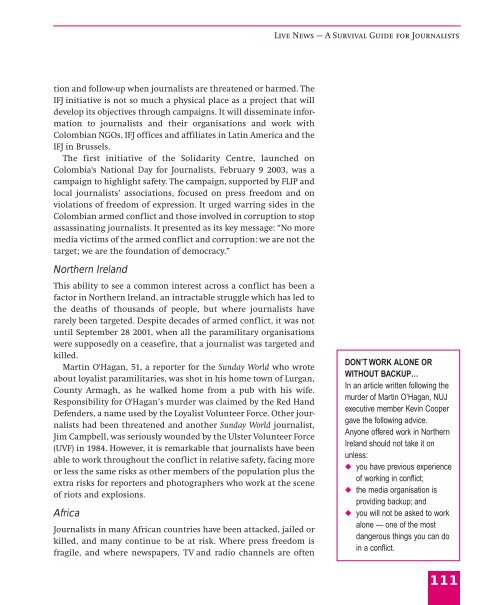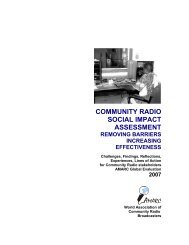Live News - A Survival Guide - International Federation of Journalists
Live News - A Survival Guide - International Federation of Journalists
Live News - A Survival Guide - International Federation of Journalists
- No tags were found...
You also want an ePaper? Increase the reach of your titles
YUMPU automatically turns print PDFs into web optimized ePapers that Google loves.
<strong>Live</strong> <strong>News</strong> — A <strong>Survival</strong> <strong>Guide</strong> for <strong>Journalists</strong>tion and follow-up when journalists are threatened or harmed. TheIFJ initiative is not so much a physical place as a project that willdevelop its objectives through campaigns. It will disseminate informationto journalists and their organisations and work withColombian NGOs, IFJ <strong>of</strong>fices and affiliates in Latin America and theIFJ in Brussels.The first initiative <strong>of</strong> the Solidarity Centre, launched onColombia's National Day for <strong>Journalists</strong>, February 9 2003, was acampaign to highlight safety. The campaign, supported by FLIP andlocal journalists’ associations, focused on press freedom and onviolations <strong>of</strong> freedom <strong>of</strong> expression. It urged warring sides in theColombian armed conflict and those involved in corruption to stopassassinating journalists. It presented as its key message: “No moremedia victims <strong>of</strong> the armed conflict and corruption: we are not thetarget; we are the foundation <strong>of</strong> democracy.”Northern IrelandThis ability to see a common interest across a conflict has been afactor in Northern Ireland, an intractable struggle which has led tothe deaths <strong>of</strong> thousands <strong>of</strong> people, but where journalists haverarely been targeted. Despite decades <strong>of</strong> armed conflict, it was notuntil September 28 2001, when all the paramilitary organisationswere supposedly on a ceasefire, that a journalist was targeted andkilled.Martin O'Hagan, 51, a reporter for the Sunday World who wroteabout loyalist paramilitaries, was shot in his home town <strong>of</strong> Lurgan,County Armagh, as he walked home from a pub with his wife.Responsibility for O'Hagan’s murder was claimed by the Red HandDefenders, a name used by the Loyalist Volunteer Force. Other journalistshad been threatened and another Sunday World journalist,Jim Campbell, was seriously wounded by the Ulster Volunteer Force(UVF) in 1984. However, it is remarkable that journalists have beenable to work throughout the conflict in relative safety, facing moreor less the same risks as other members <strong>of</strong> the population plus theextra risks for reporters and photographers who work at the scene<strong>of</strong> riots and explosions.Africa<strong>Journalists</strong> in many African countries have been attacked, jailed orkilled, and many continue to be at risk. Where press freedom isfragile, and where newspapers, TV and radio channels are <strong>of</strong>tenDON’T WORK ALONE ORWITHOUT BACKUP…In an article written following themurder <strong>of</strong> Martin O’Hagan, NUJexecutive member Kevin Coopergave the following advice.Anyone <strong>of</strong>fered work in NorthernIreland should not take it onunless:◆ you have previous experience<strong>of</strong> working in conflict;◆ the media organisation isproviding backup; and◆ you will not be asked to workalone — one <strong>of</strong> the mostdangerous things you can doin a conflict.111
















